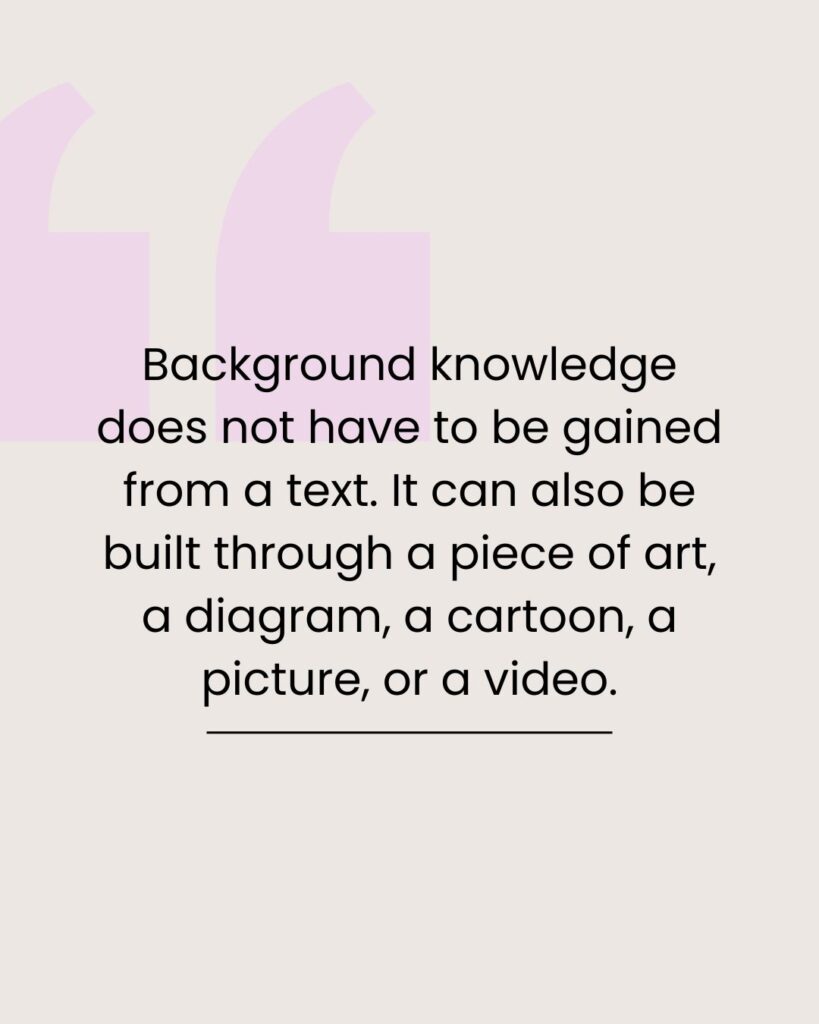When it comes to supporting English Language Learners, we often hear about “activating prior knowledge.” But what if the knowledge we assume students have . . . isn’t there yet? Or, more importantly, what if it looks different from what we expect?

The truth is, background knowledge isn’t only built through reading. As cited in Unlocking English Learners’ Potential,
“Background knowledge does not have to be gained from a text. It can also be built through a piece of art, a diagram, a cartoon, a picture, or a video” (p. 177).
This reminder is powerful because it shifts how we think about both instruction and equity.
The Equity Lens: What We Assume Shapes What We Design
Background knowledge is, at its core, an equity consideration. When teachers design units, it’s natural to lean on what we think students already know. Yet those assumptions, often shaped by our own experiences and exposures, can unintentionally create barriers, especially for multilingual learners and students whose life experiences and cultures differ from our own. By making background knowledge visible and accessible, we open the door for every student to enter the learning.
So pause and ask:
- What vocabulary and background knowledge am I assuming students bring into this unit?
- Why do I suspect they’d know it?
- Do any of these terms or concepts assume shared cultural understanding?
These aren’t small questions. They’re design questions. And they help teachers shift from deficit thinking (“Students don’t know enough”) to asset-based thinking (“Students bring knowledge that looks different from what I planned for”).
Beyond Activation: Build Background Knowledge for ELLs

For English Language Learners, it’s about building prior knowledge. That doesn’t have to happen all at once. When teachers weave background-building moments throughout a unit, learning stays responsive and social.
Consider how you might:
- – Start with visuals. Show a photograph, diagram, or short video clip to preview new concepts. Ask students what they notice to draw on their observations and curiosity.
- – Design benchmark lessons to introduce ideas and connect vocabulary to the concepts students will be learning during the unit. Plan strategic points throughout the unit for the benchmark lessons to thread concepts and skills for students.
- – Integrate peer-to-peer conversations. Pair students together to discuss visuals or videos prior to sharing as a whole class. Utilize sentence frames (a great resource for ELLs), such as “I noticed that . . .” or “I think this shows . . .” to support participation and build confidence.
- – Utilize AI tools. Your AI chatbot of choice can provide simple explanations or summaries in students’ native language, generate visuals that show concepts in different cultures, or even provide background information for students to discuss.
- – Make thinking visible. Use concept maps, anchor charts, or collaborative slidedecks for students to add images or examples that tie to new vocabulary and concepts. This can support students in seeing how ideas connect throughout the unit.
Building background knowledge isn’t frontloading; it’s threading context through the unit. When students see their cultures, languages, and experiences reflected in examples, they connect more deeply and learn more meaningfully.
Learn More
Read about IDE Corp.’s 7 Essential Elements for ELL Support.
For individuals or groups of educators, check out our Virtual Learning Community (VLC) on Strategies for Supporting ELLs. School and district leaders, if you are looking to create a culture of professional learning focused on supporting ELLs, take a look at our on-demand Professional Learning Experiences (PLEs).

 In this course, participants will leverage choice and technology to provide students with the ultimate differentiated learning environment. They will develop differentiated digital activity lists rooted in rigorous instruction that offer multiple ways to learn and apply content. Participants will explore autonomy, purpose, and mastery as motivators in all learning environments. They will design differentiated activity lists to put students in charge of their own learning, creating a structure that allows students to make decisions within a structured framework. Making informed decisions is an essential life skill that teachers can support with intentional classroom practices.
In this course, participants will leverage choice and technology to provide students with the ultimate differentiated learning environment. They will develop differentiated digital activity lists rooted in rigorous instruction that offer multiple ways to learn and apply content. Participants will explore autonomy, purpose, and mastery as motivators in all learning environments. They will design differentiated activity lists to put students in charge of their own learning, creating a structure that allows students to make decisions within a structured framework. Making informed decisions is an essential life skill that teachers can support with intentional classroom practices. Participants in this course will use Reinventing the Classroom Experience by Dr. Nancy Sulla as a resource. The assigned book must be
Participants in this course will use Reinventing the Classroom Experience by Dr. Nancy Sulla as a resource. The assigned book must be